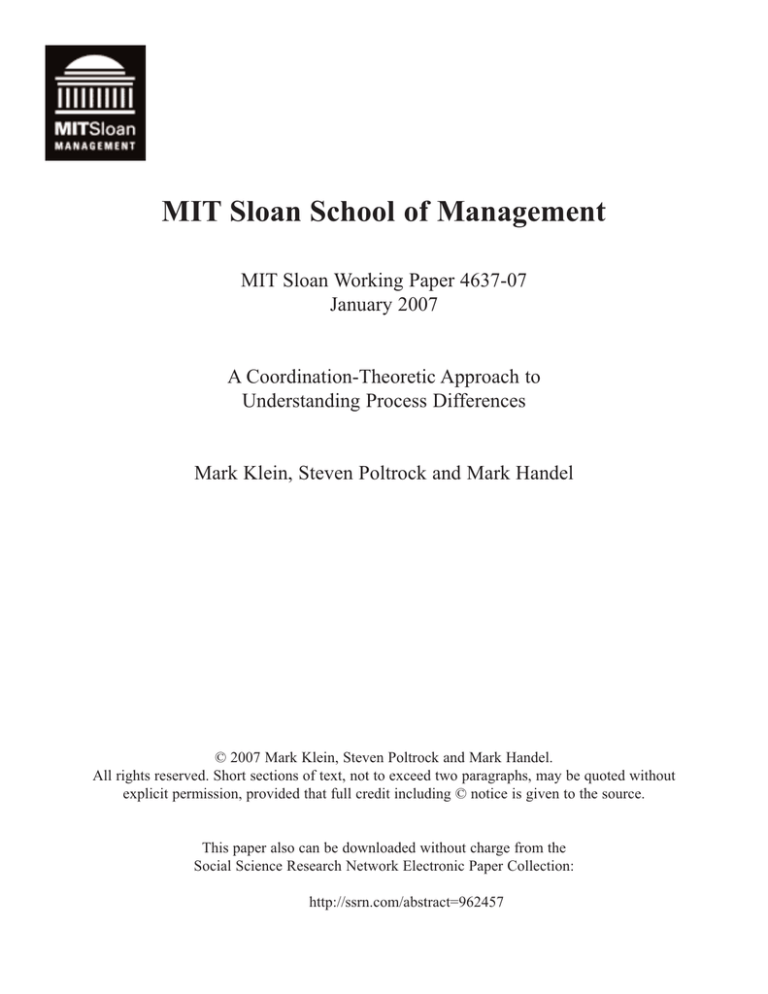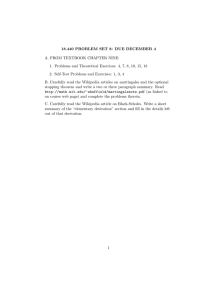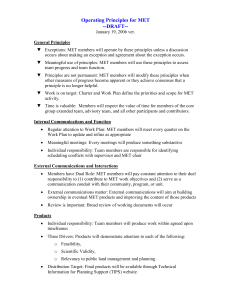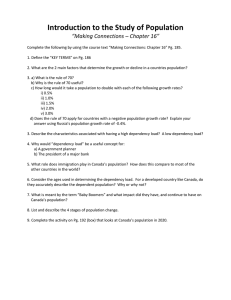
MIT Sloan School of Management
MIT Sloan Working Paper 4637-07
January 2007
A Coordination-Theoretic Approach to
Understanding Process Differences
Mark Klein, Steven Poltrock and Mark Handel
© 2007 Mark Klein, Steven Poltrock and Mark Handel.
All rights reserved. Short sections of text, not to exceed two paragraphs, may be quoted without
explicit permission, provided that full credit including © notice is given to the source.
This paper also can be downloaded without charge from the
Social Science Research Network Electronic Paper Collection:
http://ssrn.com/abstract=962457
A Coordination-Theoretic Approach to Understanding
Process Differences
Mark Klein
Massachusetts Institute of Technology
Cambridge, MA 02139
617-253-6796
m_klein@mit.edu
Steven Poltrock and Mark Handel
The Boeing Company
Seattle, WA 98124
425-373-{2729; 2883}
{steven.poltrock; mark.j.handel}@boeing.com
Abstract—Supporting human collaboration is challenging partly because of variability in how people work. Even within a
single organization, there can be many variants of processes which have the same purpose. When distinct organizations must
work together, the differences can be especially large, baffling and disruptive. Coordination theory provides a method and
vocabulary for modeling complex collaborative activities in a way that makes both the similarities and differences between
them more visible. We illustrate this, in this paper, by analyzing three engineering change management processes and
demonstrating how our method compactly highlights the substantial commonalities and precise differences between what are
on first glance are extremely divergent approaches.
1. INTRODUCTION
Multiple organizations that must work together (e.g. corporations working on a product, military organizations working on a
joint operation, non-profits working on an aid mission) often find themselves hindered by the large apparent differences in
the processes they use to accomplish what may be very similar goals. A method for identifying the root causes of their
differences may help such coalitions eliminate, reconcile, or at least understand how and why their processes differ, and lead
to more effective joint efforts.
This paper presents a top-down approach for achieving this goal, based on the insight that much collaborative work involves
activities for coordinating inter-dependent “core” tasks. Different groups, even if they have the same core tasks, may chose
different ways for coordinating them. These choices can yield work processes that appear widely divergent. Our approach is
based on making these shared core tasks and differing coordination choices readily visible.
In the following sections we introduce coordination theory and a method, based thereon, for modeling processes. We apply
this method to change management, a complex collaborative process frequently performed in engineering organizations.
Although the basic change management process is relatively constant, there is great variation in its implementation in
different contexts. We compare three different change management processes, identifying their differences in terms of the
coordination mechanisms they invoke.
2. COORDINATION THEORY
Coordination theory [4, 5, 6] is the general body of theory about how people or software agents coordinate their activities,
and it has been the subject of research in both computer science where the focus is on coordinating software agents, and the
social sciences, where the focus is on describing how people coordinate.
A key concept in coordination theory is that collaboration occurs in order to manage the dependencies between tasks. A flow
dependency exists when one person creates a product required by another person. A sharing dependency exists when a task
requires a shared resource such as the labor of people who are involved in other tasks. A fit dependency exists when two or
more people create products that must integrate. There are, of course, many ways to manage each type of dependency. People
communicate, share information with one another, and use collaboration technologies in order to manage these dependencies.
Variation in complex activities is due largely to different choices regarding how to manage these dependencies.
Malone and his colleagues [2,3,5] have developed a top-down approach to modeling complex activities. In this approach, one
defines a process by identifying the core tasks and key dependencies in that process, and then selecting the coordination
mechanisms that will be used to manage each dependency. These mechanisms may introduce new dependencies and
exceptions that will in turn require additional mechanisms and handlers. This decomposition can continue to any desired level
of detail. A key element in this approach is a large taxonomically-organized repository, known as the Process Handbook,
which captures the substeps of these mechanisms, the exceptions commonly encountered with each mechanism, as well as
handlers for resolving these exceptions. These mechanisms represent, as we shall see, high-level building blocks for creating
models of collaborative processes.
3. CHANGE MANAGEMENT
Change management is a key process in engineering organizations. A large aerospace program, for example, may have
hundreds of change management processes that govern changes to software applications, plans, requirements, costs,
schedules, configurations, and any other attribute of importance to the program. There is widespread agreement, depicted in
Figure 1, about the basic change management process, though details vary widely from one instance of the process to
another. In brief, a change is proposed and, if authorized, it is then implemented.
Figure 1 - Basic change management process
A Coordination Theoretic Model for Change Processes
In Figure 2 we illustrate the first steps of developing a model of the change process using coordination theory. We first must
identify the “deep structure” for the process, i.e. the core tasks and key dependencies. The change process consists of three
core tasks (propose changes, authorize changes, and implement changes) as well as two key dependencies (a change request
(CR) flows from the first task to the second, and an authorizing change notice (CN) flows from the second task to the third).
Next, we define a coordination mechanism for the first flow dependency. Any flow is managed by some variation of the
generic “manage flow” building block in the Handbook repository. This template captures the fact that managing a flow
always involves managing the timing, usability, and location of the resource that is flowing. Each of these subtasks,
furthermore, have their own characteristic exceptions (the manage usability step has, for example, the exception “flow wrong
thing”), and each of these exceptions has a range of processes (not shown) for handling them.
Change Management
Has part
Has part
Has part
Propose
Flow (CR)
change
Authorize
Implement
Flow (CN)
change
change
ihb
Manage flow
Has part Has part
Has part
Manage
timing
Manage
usability
Manage
location
Has exception
Has exception
Has exception
Flow
wrong
time
Flow
wrong
thing
Flow
wrong
place
Figure 2 - Top level of the change process
Avoiding Inappropriate Changes
The key challenge in change management is to avoid implementing the wrong change request or, in other words, to avoid the
“flow wrong thing” exception shown in Figure 2. Table 1 below lists some of the mechanisms in the Handbook repository
suited for handling this exception.
Avoided by
Resolved by
Detected by
Anticipated by
Avoided by
Table 1 - Handlers for “flow wrong thing”
Filter out unwanted elements (by individual or team judgment)
Filter out bad agents
Monitor agents for commitment violations
Track reputation information
Provide incentives
Most engineering organizations use variants of the “filter out unwanted elements” handler. One variant (filter by individual)
involves asking an individual to reject the change requests that in his or her judgment are not viable, while the second
involves asking a team to serve this role. The Handbook repository includes tradeoff tables that describe the relative strengths
and weaknesses of alternative processes for fulfilling a given function. The tradeoffs for the two variants of “filter out
unwanted elements” are shown in Table 2.
Table 2 - Tradeoffs for specializations of filtering out unwanted elements
Alternative
Best for
Cost
Quality
Filter by individual
Initial pruning of easy-to-find
Low
Low
problems, such as missing data
Filter by team
Careful evaluation of resource from
High
High
multiple perspectives
Speed
Fast
Slow
Filtering by individual is fast and cheap but of low quality, whereas filtering by teams is slow and more expensive but higher
in quality. In many engineering organizations, filter-by-individual is used as an initial screening step, followed by filter-byteam. The generic “filter by team” handler in the Handbook repository consists of several steps (Figure 3):
Figure 3.-The “filter by team” exception handler.
The first is to get reviews or assessments of the impact of a CR, and this requires creating a review request that is sent to all
reviewers, performing the reviews, and then consolidating the reviews into a coherent package. The filter-by-team handler
also includes making an accept/reject decision, which requires first reviewing the completed package and then making a
decision. Note that there are dependencies between these lowest level parts, and each dependency in turn requires a
coordination mechanism. Figures 2 and 3, taken together, represent a coordination-theoretic model of the change
management process used by many engineering organizations.
4. PROCESS VARIATION
When activities are collaborative, the way they are performed varies greatly from organization to organization, from one team
of participants to another, and from one time to another [1]. This is certainly true for change management. We investigated
whether such differences can be explained as a consequence of selecting different coordination mechanisms and/or different
exception handling mechanisms and, if so, whether this perspective on process variation can help us understand and, if
necessary, eliminate it.
To do so, we compared three change management processes used within one aerospace program: one for managing change to
cost and schedule (BMW), another for managing change to product configuration (CCP), and a third for managing change to
processes and tools (SIP). These are complex processes involving many people in varying roles. Applications that automate
the flow of work have been implemented for all three processes, and a portion of the BMW workflow management process
model is depicted in Figure 4 (below) to illustrate their complexity. The complexity of these processes prevents us from
presenting a complete coordination theory model; the simplest model (BMW) includes 48 steps. Even though the processes
all have essentially the same goal, the way they were modeled by their users and managers were widely divergent, the
workflow applications that support them are different, and commonalities are far from obvious.
Figure 4 – A portion of the workflow model that implements the BMW process
Our first key finding was that most of the steps in these processes involved coordination. Of the 48 tasks in BMW, for
example, 41 are coordination mechanisms (e.g. sending change requests to the reviewers, collecting and consolidating the
reviews, distributing them, holding a review meeting, and notifying the requestor about the outcome) or exception handlers
(e.g. filtering CRs and handling review requests that are sent to the wrong person or not returned on time).
A second key finding is that the differences between these processes concerned how they perform coordination and exception
handling. In order to make these differences readily visible, we created a process representation we call a “derivation tree”.
This tree captures the refinements (i.e. additions of coordination mechanisms or exception handlers used to create a process
model using the top-down analysis introduced above. The derivation tree for the generic change management process
described above, for example, is presented in Figure 5.
Figure 5.-Derivation tree for the generic change management process model.
Each arrow describes (in bold text) what aspect (dependency or exception) of the model is to be refined. The target of each
arrow captures the coordination or exception handling process selected for this purpose. These processes can in turn have
dependencies and exceptions that need to be refined. A derivation tree is generally quite compact, because a refinement often
represents the addition of a relatively large building block (i.e. a coordination mechanism or exception handler) from the
Handbook repository. The derivation tree for the BMW change process, for example, consists of 11 refinement operations,
while the conventional flowchart model for this process includes 48 steps.
Derivation trees can be used to highlight the similarities and differences between related processes. The trick is to
consolidate, into a single tree, the derivation trees for the processes being compared. Differences between the processes
become immediately evident as alternative refinements for a given dependency or exception. Figure 6 shows a consolidated
derivation tree for the BMW, CCP, and SIP change processes. Much of the tree, we can see, is shared by all three processes.
All start with the generic change approval process, and use individual and team reviews to avoid authorizing the wrong
change requests.
Figure 6 - Consolidated derivation tree comparing the BMW, CCP and SIP engineering change processes.
The small ovals represents the points of differences between the three processes, with the alternatives presented in bold font.
One difference concerns who can generate change requests. In the CCP process, any engineer can request a change. In the
BMW process, proposed changes must be submitted by engineers via a change coordinator, so the coordinator can
filter/revise inappropriate change requests before they enter the change process. In SIP, change requests must be submitted
via the project manager. A second difference is that the CCP process includes a second filter-by-individual step, performed
by the requestor’s manager. This additional step avoids the cost of a team review for CRs that are unlikely to be authorized.
The processes also differ, finally, in how people are assigned to review change requests (i.e. in how we refine the sharing
dependency between “create review request” and “perform reviews”). A fixed set of reviewers are expected to review every
CR in the SIP process, which corresponds to an allocate-via-rule mechanism. The change coordinator in the BMW process
decides who reviews CRs, which corresponds to an allocate-via-human-judgment mechanism. For the CCP process there are
thousands of potential reviewers, and no one individual can be expected to have the knowledge required to determine who
should review each CR. Instead, they use an ‘allocate by team’ mechanism, wherein members of a team make suggestions
concerning how to allocate each resource (change request), and these recommendations are consolidated somehow (e.g.
concatenated) to produce the final list of recipients (change request reviewers).
5. CONCLUSION
In this research we studied just three of hundreds of change management processes within a single aerospace program.
Although all three processes are intended to accomplish the same thing, they use different tools and procedures, and the
documentation that guides participants in these three processes looks radically different. This makes it difficult to understand
and, if desired, eliminate differences between process variants. By applying top-down coordination-theoretic modeling,
supported by a Handbook of generic coordination mechanisms and exceptions handlers, we were able to create derivation
trees for all three processes that made the source of their similarities and differences much easier to identify. With this
information in hand, we can then begin asking why the processes differ in these ways, and whether/how we want to change
them in order to make the processes more effective and more consistent.
REFERENCES
[1] Dourish, P. Where the action is: The foundations of embodied interaction. MIT Press, 2001.
[2] Klein, M. and Dellarocas, C. Designing robust business processes. Organizing business knowledge: The MIT process
handbook. The MIT Press, 2003, 423-439.
[3] Klein, M. and Petti, C. A handbook-based methodology for redesigning business processes. Knowledge and Process
Management, 13, 2006, 108-119.
[4] Malone, T.W. and Crowston, K. What is coordination theory and how can it help design cooperative work systems?
Proceedings of the Conference on Computer-Supported Cooperative Work (CSCW’90), Los Angeles, October 7-10, 1990,
pp. 357-370.
[5] Malone, T.W., Crowston, K. and Herman, G.A. Organizing business knowledge: The MIT process handbook. The MIT
Press, 2003.
[6] Malyankar, R.M. and Findler, N.V. A methodology for modeling coordination in intelligent agent societies.
Computational and Mathematical Organization Theory, 4, 1998, 317-345.
ACKNOWLEDGMENTS
MIT’s contribution to this work was funded by The Boeing Company, award MIT-BA-GTA-1.
Research was sponsored by US Army Research laboratory and the UK Ministry of Defence and was accomplished under
Agreement Number W911NF-06-3-0001. The views and conclusions contained in this document are those of the authors and
should not be interpreted as representing the official policies, either expressed or implied, of the US Army Research
Laboratory, the U.S. Government, the UK Ministry of Defense, or the UK Government. The US and UK Governments are
authorized to reproduce and distribute reprints for Government purposes notwithstanding any copyright notation hereon.



